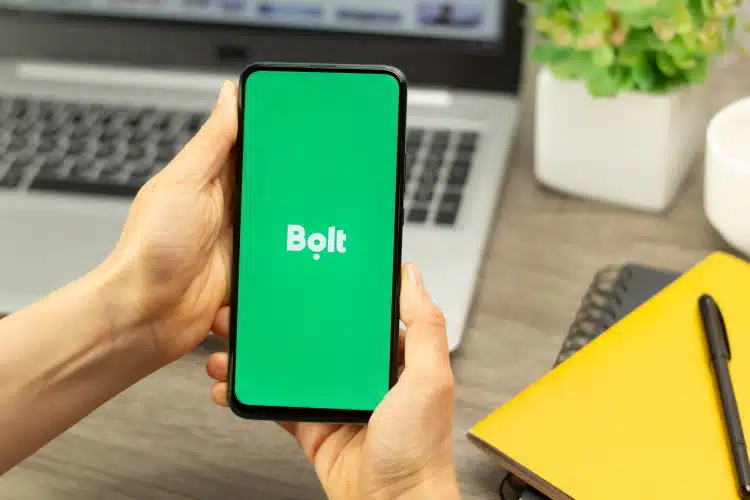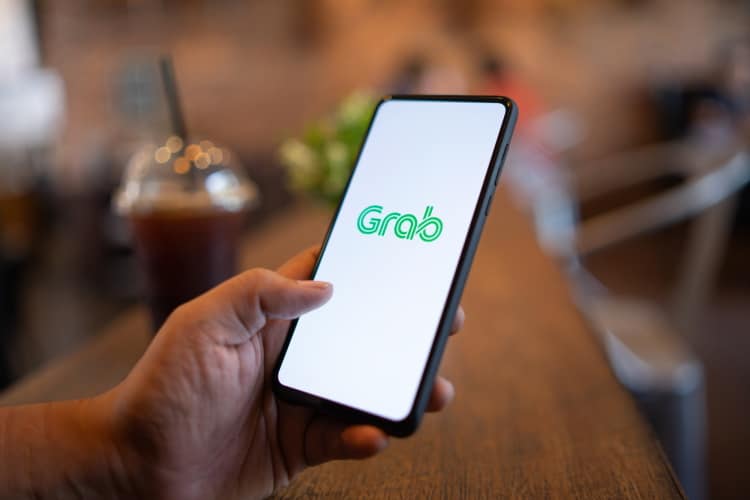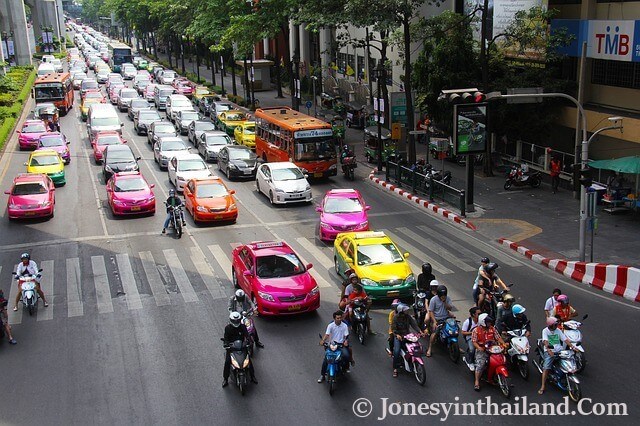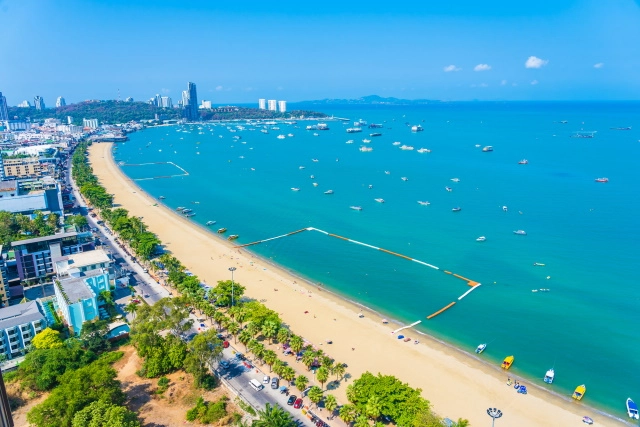Grab Taxi vs Bolt in Thailand – Which Taxi App Service is Best?
-- Last Updated on December 9, 2022 by JonesyIn Thailand’s continuously evolving transport and ride-hailing app market, Grab and Bolt are the current big names in the game. Grab rose massively in prominence after taking-over over Uber’s SE Asian operations 4 years ago, and the Singaporean company behind the app has pretty much had the monopoly on Thailand’s ride-hailing scene ever since.
Measurable data shows that Grab remains the biggest player in the Thailand ride-hailing market, although Bolt’s popularity has steadily grown since its emergence in 2020. This was boosted further by the disappearance of another competitor in 2021 by way of Gojek, not to mention the Bolt promise of lower fares, faster response times, and more service-minded drivers.
Undoubtedly these transport apps have revolutionised the ride-hailing market in Thailand and made getting around much easier than ever before. Some locals and expats may ultimately develop a preference for one or the other due to more extensive use and experience—but which is better for anyone visiting the Land of Smiles for a vacation?
Grab
Since its appearance in Thailand in 2013, Grab has made huge inroads in a variety of ways, endearing itself to locals with an ever more innovative list of localised services.
The services and features of Grab are geared largely towards convenience, which is one of the Thai nation’s favourite words. That said, the growing concerns of its monopolised price hikes have opened up something more of a gap in the market, which the newer and more competitively-priced Bolt has willingly stepped into.
Services Offered by Grab
Grab is constantly adding or upgrading its list of services which includes incentives such as GrabRewards, GrabGifts, and a cashless payment option that has become increasingly popular with locals by way of GrabPay.
The transportation services offer the following options:
- GrabTaxi
- JustGrab
- GrabCar
- GrabBike
- Private Car/Driver Rental
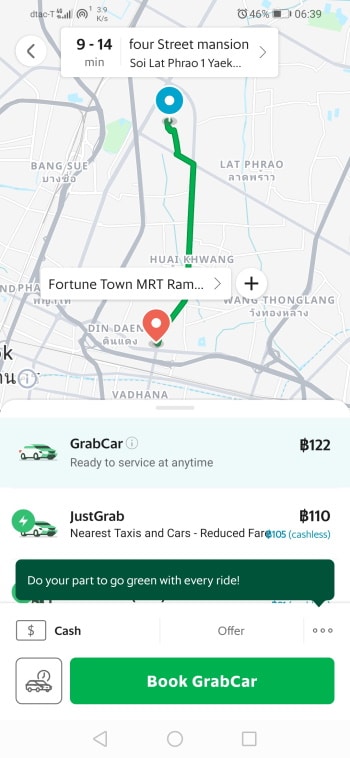
On top of that Grab does a booming line in food delivery with GrabFood, and if you don’t even want to do your own grocery shopping—or any other kind of shopping at that—then GrabMart will be right up your street.
And aside from transport, food, and shopping services comes GrabExpress, a direct delivery service that is reasonably rapid and affordable. This is another service that has rapidly grown in popularity, especially for those who don’t want to wait for or get involved with the notoriously shoddy 1-2 day delivery services in Thailand.
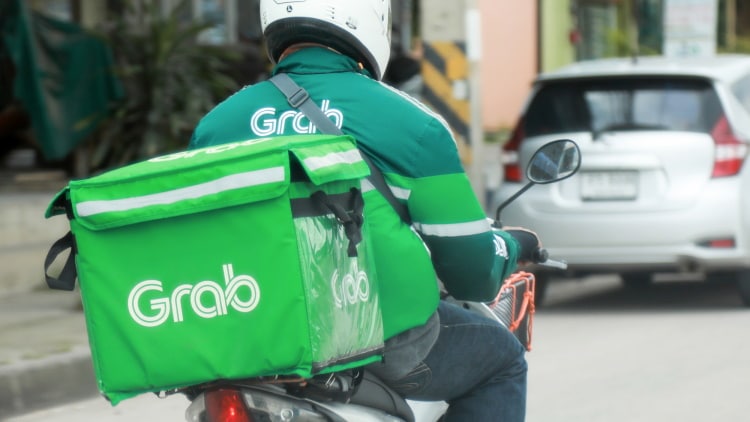
What Regions in Thailand Does Grab Cover?
Grab now operates in an ever-growing and extensive list of places. This includes not only the major cities and tourist areas but also some of the lesser-visited areas in the South and the Northeast, as follows:
- Bangkok
- Buriram
- Chiang Mai
- Chiang Rai
- Hua Hin
- Khon Kaen
- Krabi
- Nakhon Ratchasima (Korat)
- Nakhon Si Thammarat
- Pattaya
- Phuket
- Songkhla & Hat Yai
- Surat Thani & Koh Samui
- Ubon Ratchathani
- Udon Thani
Bolt
The Estonian-in-origin ride-hailer application has now expanded its operations throughout more than 30 other countries, first conquering Eastern Europe and Africa before. The app’s only current SE Asian market is Thailand, and the company seems to have done its research.

The words low and cost trump even convenience in this country, something that Bolt has used to its advantage to gain a footing in the marketplace. Pricing for Bolt depends on vehicle type and the total distance to your destination, although one of the brand’s selling points so far has been to undercut the ever-inflating prices of Grab services.
The app will show an estimate of your total journey, but this can change depending on a number of factors like waiting in traffic, route changes, or toll fees if going the tollway route.
Time will tell whether the seemingly lower-cost fares will continue as the company and its services grow. At the moment though Bolt has a somewhat shorter list of services aside from simple transport compared to Grab.
Services Offered by Bolt
Although the usual list of services is similar to those offered by Grab by way of food and grocery deliveries, at present the only options offered by Bolt in Thailand relate to transportation.
The transportation services offer the following options:
- Economy
- Standard
- Comfort
- XL
- Taxi
- Ladies Only
- Airport Transfers
- Motorbikes
The base rate for an economy car is the same as Grab but it rises at a much slower rate per km after that, undercutting Grab’s 9 baht per /km by more than half. Bolt also claims that by charging lower rates of commission than other competitors the result will be happier and thus more service-minded drivers.
Areas in Thailand currently covered by Bolt
Bolt’s services at present cover significantly fewer regions than many people would like, focusing largely on the main areas aide from Bangkok in the North South and Eastern provinces, namely:
- Bangkok
- Chiang Mai
- Phuket
- Pattaya
Bolt Pros & Cons
Transport-wise it works in the virtually the same way as Grab but is considerably cheaper. The fee structure on Bolt is quite similar to Grab but most (not all) users seem to have found Bolt offers the more affordable rates, especially for short trips. Time will tell if this trend continues as will the use of the app more extensively.
Obviously the lack of national coverage works against Bolt which seems currently more geared towards the capital and other highly-populated and well-known regions.
Bolt also offers a women-only ride option to enhance the feeling of safety for female passengers. This option for female passengers to request women drivers is a huge bonus bearing in mind that male taxi drivers in particular don’t have the best reputation in Thailand with all kinds of issues from minor to serious often being reported. On top of that it means more earning potential for women who want to drive.
The only downside is that some of the other non-transport services offered in Europe and other countries are currently unavailable. And if you are a fan of cashless payments you might be put out by the fact that only cash payments are currently accepted by Bolt in Thailand, so you’ll need some change to hand when using this service.
The app itself is user-friendly enough and requires just a download and a registered phone number to begin using it.
Grab Pros & Cons
Grab has been in the Thai market for longer, so it knows the clientele and has a set of localised features available in way more locations than Bolt, making it more high-profile. Grab also features more types of available vehicle types, and not one but three different payment options by way of cash, credit card, or GrabPay.
The app itself is easy enough to use although like the majority of other apps used in Thailand it isn’t exactly glitch-free. I’ve personally had a few incidences when it ‘froze’ or closed for no apparent reason, but these occurrences are ultimately few and far between.
Which App and Service is better?
Ultimately this will come down to personal preference and user experience. One has to bear in mind that just having even one of these apps available, let alone two (and rising) is a major development when it comes to getting around in Thailand.
The days of the temperamental and often clueless taxi drivers are becoming more and more numbered. There are also more safeguards than ever before to guard against a variety of former issues such as not knowing the route or over-charging. The use of either of these apps virtually cancels out the necessity of verbal communication altogether which is a real bonus in what is still a largely Thai-Speaking-only nation.
I would also add from personal experience that it largely depends on the driver as much as if not more so than the app that they are working with to some degree.
Bolt may seem the cheaper option—which certainly endears it to locals—but when you consider that most visitors to Thailand (at least those from Western countries) are unlikely to quibble about the fare prices when comparing them to those in their own countries there won’t be that much in it between the two operators.
The Bottom Line
It’s great to have more options when booking a taxi or car to travel around Bangkok or other locations in Thailand. Although Bolt is relatively new to the Thai market, it is a welcome addition, if not just for the purpose of keeping the Grab operators on their toes.
The growing list of transport app options when travelling within the Kingdom really does make things a lot easier, whichever one you choose to go with on a visit. You might even try both apps so that you have double the options—which is always a good thing when trying to navigate your way around a foreign country where few people speak your own language.
Let’s hope Bolt continues to improve its list of services in Thailand while keeping its prices down. This will help to ensure a more competitive and higher-quality ride-hailing market. So why not download both apps before landing in Thailand and start planning your trips and routes?
– See Grab Taxi Thailand Review or Bolt Taxi Thailand Review

Mark Philip is a writer and lifestyle enthusiast from the Midlands in the U.K. With a background in martial arts and fitness, Mark upped sticks and headed out to Bangkok to delve a bit deeper into the art of Thai Boxing way back in the 2000s, starting to write initially to fund his daily training and escape the rigours of ESL teaching. Since then Mark has authored e-books, articles, and blogs across a wide range of topics for commercial, educational, factual, health & fitness, lifestyle, wellness, and leisure-based purposes.
Related Articles
- Transport In Thailand – Transportation Guide
- Thailand Taxi Advice and Tips
- Grab Taxi Thailand Review – Using the App and Service
- Bolt Taxi Thailand Review – Using the App and Service
- Train Travel in Thailand – Guides for Tourists
- Bangkok Transport Guide – Getting Around Easily & Conveniently
- Tuk Tuks In Thailand – Tips and Advice
- Foreigners Driving in Thailand
- Bangkok Travel Guides
- Where to Stay in Bangkok?

